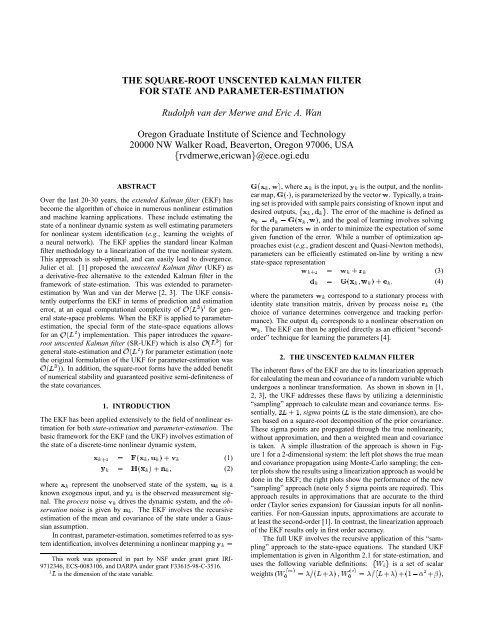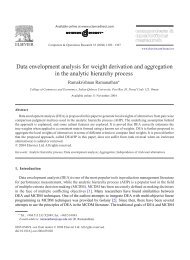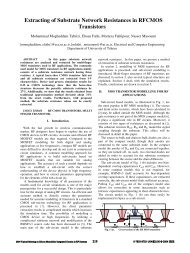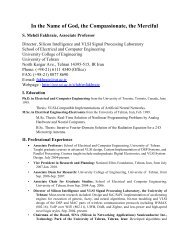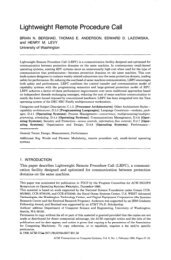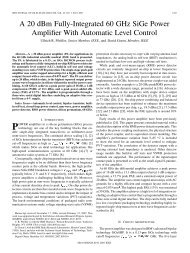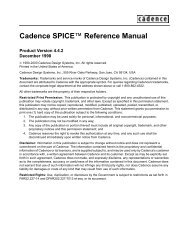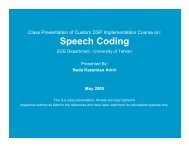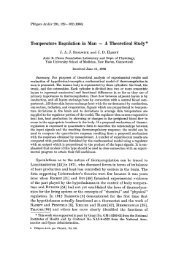THE SQUARE-ROOT UNSCENTED KALMAN FILTER FOR STATE ...
THE SQUARE-ROOT UNSCENTED KALMAN FILTER FOR STATE ...
THE SQUARE-ROOT UNSCENTED KALMAN FILTER FOR STATE ...
Create successful ePaper yourself
Turn your PDF publications into a flip-book with our unique Google optimized e-Paper software.
<strong>THE</strong> <strong>SQUARE</strong>-<strong>ROOT</strong> <strong>UNSCENTED</strong> <strong>KALMAN</strong> <strong>FILTER</strong><br />
<strong>FOR</strong> <strong>STATE</strong> AND PARAMETER-ESTIMATION<br />
Rudolph van der Merwe and Eric A. Wan<br />
Oregon Graduate Institute of Science and Technology<br />
20000 NW Walker Road, Beaverton, Oregon 97006, USA<br />
�rvdmerwe,ericwan�@ece.ogi.edu<br />
ABSTRACT<br />
Over the last 20-30 years, the extended Kalman filter (EKF) has<br />
become the algorithm of choice in numerous nonlinear estimation<br />
and machine learning applications. These include estimating the<br />
state of a nonlinear dynamic system as well estimating parameters<br />
for nonlinear system identification (e.g., learning the weights of<br />
a neural network). The EKF applies the standard linear Kalman<br />
filter methodology to a linearization of the true nonlinear system.<br />
This approach is sub-optimal, and can easily lead to divergence.<br />
Julier et al. [1] proposed the unscented Kalman filter (UKF) as<br />
a derivative-free alternative to the extended Kalman filter in the<br />
framework of state-estimation. This was extended to parameterestimation<br />
by Wan and van der Merwe [2, 3]. The UKF consistently<br />
outperforms the EKF in terms of prediction and estimation<br />
error, at an equal computational complexity of Ç Ä 1 for general<br />
state-space problems. When the EKF is applied to parameterestimation,<br />
the special form of the state-space equations allows<br />
for an Ç Ä implementation. This paper introduces the squareroot<br />
unscented Kalman filter (SR-UKF) which is also Ç Ä for<br />
general state-estimation and Ç Ä for parameter estimation (note<br />
the original formulation of the UKF for parameter-estimation was<br />
Ç Ä ). In addition, the square-root forms have the added benefit<br />
of numerical stability and guaranteed positive semi-definiteness of<br />
the state covariances.<br />
1. INTRODUCTION<br />
The EKF has been applied extensively to the field of nonlinear estimation<br />
for both state-estimation and parameter-estimation. The<br />
basic framework for the EKF (and the UKF) involves estimation of<br />
the state of a discrete-time nonlinear dynamic system,<br />
� � � �� � � (1)<br />
Ý� � À Ü� Ò�� (2)<br />
where � represent the unobserved state of the system, � is a<br />
known exogenous input, and � is the observed measurement signal.<br />
The process noise Ú� drives the dynamic system, and the observation<br />
noise is given by Ò�. The EKF involves the recursive<br />
estimation of the mean and covariance of the state under a Gaussian<br />
assumption.<br />
In contrast, parameter-estimation, sometimes referred to as system<br />
identification, involves determining a nonlinear mapping � �<br />
This work was sponsored in part by NSF under grant grant IRI-<br />
9712346, ECS-0083106, and DARPA under grant F33615-98-C-3516.<br />
1 Ä is the dimension of the state variable.<br />
� Ü�� Û ,whereÜ� is the input, Ý� is the output, and the nonlinear<br />
map, � ¡ , is parameterized by the vector Û. Typically, a training<br />
set is provided with sample pairs consisting of known input and<br />
desired outputs, ��� ���. The error of the machine is defined as<br />
�� � �� � Ü�� Û , and the goal of learning involves solving<br />
for the parameters Û in order to minimize the expectation of some<br />
given function of the error. While a number of optimization approaches<br />
exist (e.g., gradient descent and Quasi-Newton methods),<br />
parameters can be efficiently estimated on-line by writing a new<br />
state-space representation<br />
Û� � Û� Ö� (3)<br />
�� � � �� � ��� (4)<br />
where the parameters Û� correspond to a stationary process with<br />
identity state transition matrix, driven by process noise Ö� (the<br />
choice of variance determines convergence and tracking performance).<br />
The output �� corresponds to a nonlinear observation on<br />
Û�. The EKF can then be applied directly as an efficient “secondorder”<br />
technique for learning the parameters [4].<br />
2. <strong>THE</strong> <strong>UNSCENTED</strong> <strong>KALMAN</strong> <strong>FILTER</strong><br />
The inherent flaws of the EKF are due to its linearization approach<br />
for calculating the mean and covariance of a random variable which<br />
undergoes a nonlinear transformation. As shown in shown in [1,<br />
2, 3], the UKF addresses these flaws by utilizing a deterministic<br />
“sampling” approach to calculate mean and covariance terms. Essentially,<br />
Ä ,sigma points (Ä is the state dimension), are chosen<br />
based on a square-root decomposition of the prior covariance.<br />
These sigma points are propagated through the true nonlinearity,<br />
without approximation, and then a weighted mean and covariance<br />
is taken. A simple illustration of the approach is shown in Figure<br />
1 for a 2-dimensional system: the left plot shows the true mean<br />
and covariance propagation using Monte-Carlo sampling; the center<br />
plots show the results using a linearization approach as would be<br />
done in the EKF; the right plots show the performance of the new<br />
“sampling” approach (note only 5 sigma points are required). This<br />
approach results in approximations that are accurate to the third<br />
order (Taylor series expansion) for Gaussian inputs for all nonlinearities.<br />
For non-Gaussian inputs, approximations are accurate to<br />
at least the second-order [1]. In contrast, the linearization approach<br />
of the EKF results only in first order accuracy.<br />
The full UKF involves the recursive application of this “sampling”<br />
approach to the state-space equations. The standard UKF<br />
implementation is given in Algorithm 2.1 for state-estimation, and<br />
uses the following variable definitions: ��� is a set of scalar<br />
weights (Ï Ñ � �� Ä � , Ï � �� Ä � « ¬ ,
Actual (sampling) Linearized (EKF) UKF UT<br />
Ý � � Ü<br />
mean<br />
true mean<br />
covariance<br />
true covariance<br />
� Ì È Ü�<br />
�Ý � � �Ü<br />
ÈÝ � � Ì ÈÜ�<br />
� �Ü<br />
sigma points<br />
0000 1111<br />
UKF UT mean<br />
0000 1111<br />
� � � �<br />
weighted sample mean<br />
and covariance<br />
UKF 00000 11111<br />
UT covariance<br />
01<br />
11111<br />
000000<br />
10<br />
1<br />
01<br />
01<br />
01<br />
0000 1111<br />
0000 1111<br />
0000 1111<br />
0000 1111<br />
0000 1111<br />
transformed<br />
sigma points<br />
Figure 1: Example of mean and covariance propagation. a) actual,<br />
b) first-order linearization (EKF), c) new “sampling” approach (UKF).<br />
Ï Ñ<br />
� � Ï� � �� Ä � � � � ����� Ä). � � Ô « Ä<br />
� Ä and � Ä � are scaling parameters. The constant «<br />
determines the spread of the sigma points around �Ü and is usually<br />
set to � � � « � . � is a secondary scaling parameter 2 . ¬<br />
is used to incorporate prior knowledge of the distribution of Ü (for<br />
Gaussian distributions, ¬ � is optimal). Also note that we define<br />
the linear algebra operation of adding a column vector to a matrix,<br />
i.e. � ¦ Ù as the addition of the vector to each column of the matrix.<br />
The superior performance of the UKF over the EKF has been<br />
demonstrated in a number of applications [1, 2, 3]. Furthermore,<br />
unlike the EKF, no explicit derivatives (i.e., Jacobians or Hessians)<br />
need to be calculated.<br />
3. EFFICIENT <strong>SQUARE</strong>-<strong>ROOT</strong> IMPLEMENTATION<br />
The most computationally expensive operation in the UKF corresponds<br />
to calculating the new set of sigma points at each time<br />
update. This requires taking a matrix square-root of the state covariance<br />
matrix 3 , È Ê Ä¢Ä ,givenbyËË Ì � È. An efficient<br />
implementation using a Cholesky factorization requires in general<br />
Ç Ä �� computations [5]. While the square-root of È is an integral<br />
part of the UKF, it is still the full covariance È which is recursively<br />
updated. In the SR-UKF implementation, Ë will be propagated<br />
directly, avoiding the need to refactorize at each time step.<br />
The algorithm will in general still beÇ Ä , but with improved numerical<br />
properties similar to those of standard square-root Kalman<br />
filters [6]. Furthermore, for the special state-space formulation of<br />
parameter-estimation, an Ç Ä implementation becomes possible.<br />
The square-root form of the UKF makes use of three linear<br />
algebra techniques[5] nl. QR decomposition, Cholesky factor updating<br />
and efficient least squares, which we briefly review below:<br />
¯ QR decomposition. The QR decomposition or factorization<br />
of a matrix � Ê Ä¢Æ is given by, � Ì � ÉÊ, where<br />
É Ê Æ¢Æ is orthogonal, Ê Ê Æ¢Ä is upper triangular<br />
and Æ � Ä. The upper triangular part of Ê, � Ê,is<br />
2We usually set � to<br />
estimation [1].<br />
for state-estimation and to Ä for parameter<br />
3For notational clarity, the time index � has been omitted.<br />
Initialize with:<br />
�Ü � ��Ü ℄ È � �� Ü �Ü Ü �Ü Ì ℄ (5)<br />
For � � ����� �,<br />
Calculate sigma points:<br />
� �<br />
�<br />
� �Ü� �Ü� Ô È� �Ü� Ô È�<br />
Time update:<br />
� £<br />
��� � ��� � � Ù� ℄ (7)<br />
�Ü<br />
� �<br />
��<br />
�<br />
�<br />
È � �<br />
5� ���<br />
�� �<br />
� �Ü �<br />
Ï Ñ<br />
�<br />
� £<br />
�����<br />
Ï� �� £<br />
£<br />
����� �Ü � ℄�� ����� �Ü � ℄Ì Ê Ú<br />
�Ü<br />
�<br />
���� � À�� ��� ℄<br />
�Ý<br />
� �<br />
��<br />
�<br />
Measurement update equations:<br />
�� �� �<br />
ÈÜ�Ý� �<br />
��<br />
��<br />
�<br />
�<br />
Ã� � ÈÜ�Ý� È<br />
�� ��<br />
�Ü� � �Ü<br />
�<br />
Õ<br />
È �<br />
�Ü<br />
� <br />
Õ<br />
È �<br />
�<br />
�<br />
(6)<br />
(8)<br />
(9)<br />
Ï Ñ<br />
� ������ (10)<br />
Ï � ������� �Ý<br />
� ℄������� �Ý<br />
� ℄Ì Ê Ò<br />
Ï � ������� �Ü<br />
� ℄������� �Ý<br />
� ℄Ì<br />
Ã� Ý� �Ý<br />
�<br />
È� � È � Ã�È�Ý��Ý�ÃÌ �<br />
where Ê Ú =process noise cov., Ê Ò =measurement noise cov.<br />
Algorithm 2.1: Standard UKF algorithm.<br />
(11)<br />
(12)<br />
(13)<br />
(14)<br />
the transpose of the Cholesky factor of È � �� Ì , i.e.,<br />
�Ê � Ë Ì , such that � Ê Ì � Ê � �� Ì . Weusetheshorthand<br />
notation qr�¡� to donate a QR decomposition of a matrix<br />
where only � Ê is returned. The computational complexity<br />
of a QR decomposition is Ç ÆÄ . Note that performing a<br />
Cholesky factorization directly on È � �� Ì is Ç Ä ��<br />
plus Ç ÆÄ to form �� Ì .<br />
¯ Cholesky factor updating. If Ë is the original Cholesky factor<br />
of È � �� Ì , then the Cholesky factor of the rank-<br />
1 update (or downdate) È ¦ Ô �ÙÙ Ì is denoted as Ë �<br />
cholupdate�Ë� Ù�¦��. If Ù is a matrix and not a vector,<br />
then the result is Å consecutive updates of the Cholesky<br />
factor using the Å columns of Ù. This algorithm (available<br />
in Matlab as cholupdate) is only Ç Ä per update.<br />
¯ Efficient least squares. The solution to the equation<br />
�� Ì Ü � � Ì � also corresponds to the solution of the<br />
overdetermined least squares problem �Ü � �. This can be<br />
solved efficiently using a QR decomposition with pivoting
(implemented in Matlab’s ’/’ operator).<br />
The complete specification of the new square-root filters is<br />
given in Algorithm 3.1 for state-estimation and 3.2 for paramaterestimation.<br />
Below we describe the key parts of the square-root<br />
algorithms, and how they contrast with the stardard implementations.<br />
Square-Root State-Estimation: As in the original UKF, the<br />
filter is initialized by calculating the matrix square-root of the state<br />
covariance once via a Cholesky factorization (Eqn. 16). However,<br />
the propagted and updated Cholesky factor is then used in subsequent<br />
iterations to directly form the sigma points. In Eqn. 20<br />
the time-update of the Cholesky factor, Ë , is calculated using a<br />
QR decompostion of the compound matrix containing the weighted<br />
propagated sigma points and the matrix square-root of the additive<br />
process noise covariance. The subsequent Cholesky update (or<br />
downdate) in Eqn. 21 is necessary since the the zero’th weight,<br />
Ï , may be negative. These two steps replace the time-update<br />
of È in Eqn. 8, and is also Ç Ä .<br />
The same two-step approach is applied to the calculation of<br />
the Cholesky factor, Ë�Ý, of the observation-error covariance in<br />
Eqns. 25 and 26. This step is Ç ÄÅ ,whereÅis the observation<br />
dimension. In contrast to the way the Kalman gain is calculated<br />
in the standard UKF (see Eqn. 12), we now use two nested<br />
inverse (or least squares) solutions to the following expansion of<br />
Eqn. 12, Ã� Ë�Ý� ËÌ�Ý� � ÈÜ�Ý� . Since Ë�Ý is square and triangular,<br />
efficient “back-substitutions” can be used to solve for Ã�<br />
directly without the need for a matrix inversion.<br />
Finally, the posterior measurement update of the Cholesky factor<br />
of the state covariance is calculated in Eqn. 30 by applying Å<br />
sequential Cholesky downdates to Ë � . The downdate vectors are<br />
the columns of Í � Ã�Ë�Ý� . This replaces the posterior update of<br />
È� in Eqn. 14, and is also Ç ÄÅ .<br />
Square-Root Parameter-Estimation: The parameter-estimation<br />
algorithm follows a similar framework as that of the state-estimation<br />
square-root UKF. However, an Ç ÅÄ algorithm, as opposed to<br />
Ç Ä , is possible by taking advantage of the linear state transition<br />
function. Specifically, the time-update of the state covariance<br />
is given simply by È Û� � ÈÛ� Ê Ö � . Now, if we apply an<br />
exponential weighting on past data 4 , the process noise covariance<br />
is given by Ê Ö � � � ÊÄË ÈÛ� , and the time update of the<br />
state covariance becomes,<br />
È Û� � ÈÛ� � ÊÄË ÈÛ� � � ÊÄËÈÛ� � (15)<br />
�<br />
This translates readily into the factored form, Ë Û�<br />
� � ÊÄË ËÛ�<br />
(see Eqn. 33), and avoids the costlyÇ Ä QR and Cholesky based<br />
updates necessary in the state-estimation filter. This Ç ÅÄ time<br />
update step has recently been expanded by the authors to deal with<br />
arbitrary diagonal noise covariance structures [7].<br />
4. EXPERIMENTAL RESULTS<br />
The improvement in error performance of the UKF over that of the<br />
EKF for both state and parameter-estimation is well documented<br />
[1, 2, 3]. The focus of this section will be to simply verify the<br />
equivalent error performance of the UKF and SR-UKF, and show<br />
the reduction in computational cost achieved by the SR-UKF for<br />
4 This is identical to the approach used in weighted recursive least<br />
squares (W-RLS). �ÊÄË is a scalar weighting factor chosen to be slightly<br />
less than 1, i.e. �ÊÄË � �����.<br />
5 Redraw sigma points to incorporate effect of process noise.<br />
Initialize with:<br />
�Ü � ��Ü ℄ Ë � chol<br />
For � � ����� �,<br />
Ò Ó<br />
Ì<br />
�� Ü �Ü Ü �Ü ℄<br />
(16)<br />
Sigma point calculation and time update:<br />
� � ���Ü� �Ü� Ë� �Ü� Ë�℄ (17)<br />
� £<br />
��� � ��� � � Ù� ℄ (18)<br />
�Ü<br />
� �<br />
�<br />
Ï Ñ<br />
�<br />
� £<br />
�����<br />
(19)<br />
��<br />
��Õ<br />
£ ¡ Ô ��<br />
Ë � � qr Ï � � Ä���� �Ü � ÊÚ (20)<br />
Ò Ó<br />
£<br />
Ë � � cholupdate Ë � � � �� �Ü � � Ï (21)<br />
¢ £<br />
5 � ��� � �Ü � �Ü � Ë � �Ü � Ë �<br />
(22)<br />
� ��� � À�� ��� ℄ (23)<br />
�Ý<br />
� �<br />
��<br />
�<br />
Ï Ñ<br />
� ������ (24)<br />
Measurement update equations:<br />
��Õ<br />
� qr Ï �� � Ä�� �Ý�℄<br />
��<br />
��<br />
ÈÜ�Ý� �<br />
� cholupdate<br />
��<br />
�<br />
Ô Ê Ò �<br />
Ò Ë�Ý� � � �� �Ý� � Ï<br />
��<br />
Ï � ������� �Ü<br />
� ℄������� �Ý<br />
� ℄Ì<br />
Ó<br />
(25)<br />
(26)<br />
(27)<br />
Ã� � ÈÜ�Ý� �ËÌ �Ý� �Ë�Ý� (28)<br />
�Ü� � �Ü<br />
�<br />
Í � Ã�Ë�Ý�<br />
Ã� Ý� �Ý<br />
�<br />
Ë� � cholupdate ¨ Ë<br />
�<br />
� Í � -1©<br />
where Ê Ú =process noise cov., Ê Ò =measurement noise cov.<br />
Algorithm 3.1: Square-Root UKF for state-estimation.<br />
(29)<br />
(30)<br />
parameter-estimation. Figure 2 shows the superior performance of<br />
UKF and SR-UKF compared to that of the EKF on estimating the<br />
Mackey-Glass-30 chaotic time series corrupted by additive white<br />
noise (3dB SNR). The error performance of the SR-UKF and UKF<br />
are indistinguishable and are both superior to the EKF. The computational<br />
complexity of all three filters are of the same order but the<br />
SR-UKF is about 20% faster than the UKF and about 10% faster<br />
than the EKF.<br />
The next experiment shows the reduction in computational cost<br />
achieved by the square-root unscented Kalman filters and how that<br />
compares to the computational complexity of the EKF for parameterestimation.<br />
For this experiment, we use an EKF, UKF and SR-UKF<br />
to train a 2-12-2 MLP neural network on the well known Mackay-<br />
Robot-Arm 6 benchmark problem of mapping the joint angles of a<br />
robot arm to the Cartesian coordinates of the hand. The learning<br />
curves (mean square error (MSE) vs. learning epoch) of the different<br />
filters are shown in Figure 3. Figure 4 shows how the com-<br />
6 http://wol.ra.phy.cam.ac.uk/mackay
Initialize with:<br />
�Û � ��Û℄ ËÛ � chol<br />
For � � ����� �,<br />
Time update and sigma point calculation:<br />
Ò Ó<br />
Ì<br />
�� Û �Û Û �Û ℄ (31)<br />
�Û<br />
� � �Û� (32)<br />
�<br />
Ë Û�<br />
� � ÊÄË ËÛ�<br />
¢<br />
Ï ��� � �Û � �Û � Ë Û�<br />
(33)<br />
�Û<br />
£<br />
� Ë Û� (34)<br />
���� � ��Ü�� Ï ��� ℄ (35)<br />
��� �<br />
��<br />
Measurement update equations:<br />
��Õ �<br />
� qr Ï � � Ä�� � ��<br />
��<br />
��<br />
ÈÛ��� �<br />
�<br />
� cholupdate<br />
��<br />
�<br />
Ï Ñ<br />
� ������ (36)<br />
� Ô ��<br />
Ê� Ò<br />
Ë�� � � �� � Ó<br />
�� � Ï<br />
Ï � �Ï����� �Û<br />
� ℄������� � ��℄ Ì<br />
(37)<br />
(38)<br />
(39)<br />
Ã� � ÈÛ��� �ËÌ �� �Ë�� (40)<br />
�Û� � �Û � Ã� �� � �� (41)<br />
Í � Ã�Ë��<br />
(42)<br />
ËÛ� � cholupdate ¨ Ë Û� � Í � -1©<br />
(43)<br />
where Ê � =measurement noise cov (this can be set to an arbitrary<br />
value, e.g., ��Á.)<br />
Algorithm 3.2: Square-Root UKF for parameter-estimation.<br />
x(k)<br />
x(k)<br />
5<br />
0<br />
Estimation of Mackey−Glass time series : EKF<br />
clean<br />
noisy<br />
EKF<br />
−5<br />
850 900 950 1000<br />
k<br />
Estimation of Mackey−Glass time series : UKF & SR−UKF<br />
5<br />
clean<br />
noisy<br />
UKF<br />
SR−UKF<br />
0<br />
−5<br />
850 900 950 1000<br />
k<br />
Figure 2: Estimation of the Mackey-Glass chaotic time-series (modeled<br />
by a neural network) with the EKF, UKF and SR-UKF.<br />
putational complexity of the different filters scale as a function of<br />
the number of parameters (weights in neural network). While the<br />
standard UKF is Ç Ä , both the EKF and SR-UKF are Ç Ä .<br />
MSE<br />
10 0<br />
10 −1<br />
10 −2<br />
10 −3<br />
Learning Curves : NN parameter estimation<br />
EKF<br />
UKF<br />
SR−UKF<br />
5 10 15 20 25<br />
epoch<br />
30 35 40 45 50<br />
Figure 3: Learning curves for Mackay-Robot-Arm neural network<br />
parameter-estimation problem.<br />
flops<br />
2<br />
1.5<br />
1<br />
0.5<br />
x 10 10<br />
EKF<br />
UKF<br />
SR−UKF<br />
Computational Complexity Comparison<br />
100 200 300 400 500 600<br />
number of parameters (L)<br />
Figure 4: Computational complexity (flops/epoch) of EKF, UKF and<br />
SR-UKF for parameter-estimation (Mackay-Robot-Arm problem).<br />
5. CONCLUSIONS<br />
The UKF consistently performs better than or equal to the well<br />
known EKF, with the added benefit of ease of implementation in<br />
that no analytical derivatives (Jacobians or Hessians) need to be<br />
calculated. For state-estimation, the UKF and EKF have equal<br />
complexity and are in general Ç Ä . In this paper, we introduced<br />
square-root forms of the UKF. The square-root UKF has better<br />
numerical properties and guarantees positive semi-definiteness<br />
of the underlying state covariance. In addition, for parameterestimation<br />
an efficient Ç Ä implementation is possible for the<br />
square-root form, which is again of the same complexity as efficient<br />
EKF parameter-estimation implementations.<br />
6. REFERENCES<br />
[1] S. J. Julier and J. K. Uhlmann, “A New Extension of the<br />
Kalman Filter to Nonlinear Systems,” in Proc. of AeroSense:<br />
The 11th Int. Symp. on Aerospace/Defence Sensing, Simulation<br />
and Controls., 1997.<br />
[2] E. Wan, R. van der Merwe, and A. T. Nelson, “Dual Estimation<br />
and the Unscented Transformation,” in Neural Information<br />
Processing Systems 12. 2000, pp. 666–672, MIT Press.<br />
[3] E. A. Wan and R. van der Merwe, “The Unscented Kalman<br />
Filter for Nonlinear Estimation,” in Proc. of IEEE Symposium<br />
2000 (AS-SPCC), Lake Louise, Alberta, Canada, Oct. 2000.<br />
[4] G.V. Puskorius and L.A. Feldkamp, “Decoupled Extended<br />
Kalman Filter Training of Feedforward Layered Networks,” in<br />
IJCNN, 1991, vol. 1, pp. 771–777.<br />
[5] W. H. Press, S. A. Teukolsky, W. T. Vetterling, and B. P. Flannery,<br />
Numerical Recipes in C : The Art of Scientific Computing,<br />
Cambridge University Press, 2 edition, 1992.<br />
[6] A. H. Sayed and T. Kailath, “A State-Space Approach to<br />
Adaptive RLS Filtering,” IEEE Sig. Proc. Mag., July 1994.<br />
[7] R. van der Merwe and E. A. Wan, “Efficient Derivative-Free<br />
Kalman Filters for Online Learning,” in ESANN, Bruges, Belgium,<br />
Apr. 2001.


